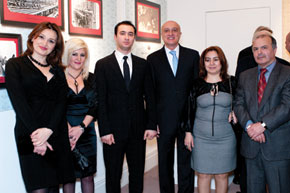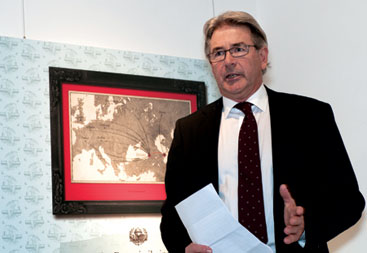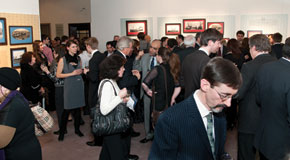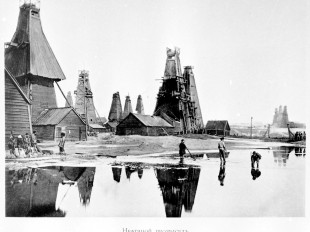Pages 28-29
by Fiona Maclachlan
Who hasn’t heard of the Nobel Peace Prize? Promoting the exciting history of the oil industry in Baku, “The Nobels and Baku Oil” is an exhibition which, since its first opening in Baku in September 2009, has been available to view in a number of the world’s cities. Quite simply, the exhibition tells the story of the Nobel Brothers in Baku and how they influenced and modernised the oil industry, effecting change not only in Baku but throughout the world. Many people have heard of the Nobel Peace Prize but not so many understand that some of the money behind the prize came from this successful extraction of oil from the bountiful oilfields of Baku, over a hundred years ago.
On 25 November 2010, I went along to a very well-attended opening of the exhibition at Sotheby’s in London, the second time the exhibition has been available to view in the city. The event was run over four days by The European Azerbaijan Society (TEAS), and was generously sponsored by Socar, Statoil, Rapid Solutions and DLA Piper. The opening attracted a wide range of guests, all of whom were enthusiastic about both the exhibition and of course Azerbaijan itself, and the opportunities it offers to business person and tourist alike.
TEAS organised speakers for the event; Tale Heydarov, Chairman and Founder of TEAS, welcomed everyone and Azerbaijan’s Ambassador to the UK, H.E. Fakhraddin Gurbanov also spoke warmly.  (from left) Amina Melikova, Director, Expo Org; Azada Huseynova, Azerbaijani Ministry of Culture and Tourism; Tale Heydarov, Chairman, TEAS; H.E. Ambassador Gurbanov; Naida Abbasova, Curator, Expo Org; and Professor Mir-Yusif Mir-Babayev, Azerbaijan Technical University Tanguy Cosmau from Statoil explained that he is French, works for a company believed to be Scandinavian, and lives in Baku, thus cheerfully acknowledging the international nature of people and companies involved in Azerbaijan. Azada Huseynova, Head of the Museum Affairs Department of the Azerbaijani Ministry of Culture and Tourism, also spoke about the exhibition. But when the final speaker for the evening, Mr. Gustaf Nobel of the Nobel Charitable Trust, took the stage, there was an audible gasp from guests when he introduced himself as the grandson of Ludvig Nobel.
(from left) Amina Melikova, Director, Expo Org; Azada Huseynova, Azerbaijani Ministry of Culture and Tourism; Tale Heydarov, Chairman, TEAS; H.E. Ambassador Gurbanov; Naida Abbasova, Curator, Expo Org; and Professor Mir-Yusif Mir-Babayev, Azerbaijan Technical University Tanguy Cosmau from Statoil explained that he is French, works for a company believed to be Scandinavian, and lives in Baku, thus cheerfully acknowledging the international nature of people and companies involved in Azerbaijan. Azada Huseynova, Head of the Museum Affairs Department of the Azerbaijani Ministry of Culture and Tourism, also spoke about the exhibition. But when the final speaker for the evening, Mr. Gustaf Nobel of the Nobel Charitable Trust, took the stage, there was an audible gasp from guests when he introduced himself as the grandson of Ludvig Nobel.
Living history
The exhibition uses original film footage and historical photographs, together with modern explanations and graphics, to demonstrate the technological and social breakthroughs which were achieved under the Nobel Brothers, who formed the company Branobel in 1879. The period is vividly brought to life. As I look at the exhibits, I wonder if the people in the pictures realised the significance of their work, that we would be looking at it with such wonder a hundred years on. And it’s amazing really that all the information was kept and could be found in order to create this exhibition.
The step by step advances in drilling technology are cleverly demonstrated, using old film skilfully combined with modern graphics. The delivery of oil to its buyers is also well described. We see a photograph of an oil barrel strapped under a cart, pulled by a horse or donkey. As the amounts of oil increased with the improving drilling technology, Zoroaster, the world’s first oil tanker, was built. And then the world’s first oil pipelines were built. The exhibition looks at the pipeline requirements, their design and there is even an old film of the construction of the Baku to Batumi pipeline. Compare it with the modern day Baku-Tbilisi-Ceyhan pipeline, which is often described as the world’s most strategic pipeline. Some things have really changed, others less so - look at the horse patrols!
You need to take a careful look at the text in the exhibition to really understand how innovative the Nobel Brothers were. And not just in engineering. The Nobel way of doing business meant that, for the first time in this whole region, workers were treated with respect, they were given canteens, proper (and shorter) working hours, medical facilities, help with decent housing and so on. This must have had a major impact on the life of people in the city.
The influence of the Nobel Brothers in Baku, during this glorious period of Baku’s history, is quite amazing, and the exhibition - while excellent - I think actually understates the international significance of their achievements. If you get a chance to see this exhibition, then do go along and see if you agree with me.
by Fiona Maclachlan
Who hasn’t heard of the Nobel Peace Prize? Promoting the exciting history of the oil industry in Baku, “The Nobels and Baku Oil” is an exhibition which, since its first opening in Baku in September 2009, has been available to view in a number of the world’s cities. Quite simply, the exhibition tells the story of the Nobel Brothers in Baku and how they influenced and modernised the oil industry, effecting change not only in Baku but throughout the world. Many people have heard of the Nobel Peace Prize but not so many understand that some of the money behind the prize came from this successful extraction of oil from the bountiful oilfields of Baku, over a hundred years ago.
On 25 November 2010, I went along to a very well-attended opening of the exhibition at Sotheby’s in London, the second time the exhibition has been available to view in the city. The event was run over four days by The European Azerbaijan Society (TEAS), and was generously sponsored by Socar, Statoil, Rapid Solutions and DLA Piper. The opening attracted a wide range of guests, all of whom were enthusiastic about both the exhibition and of course Azerbaijan itself, and the opportunities it offers to business person and tourist alike.
TEAS organised speakers for the event; Tale Heydarov, Chairman and Founder of TEAS, welcomed everyone and Azerbaijan’s Ambassador to the UK, H.E. Fakhraddin Gurbanov also spoke warmly.
 (from left) Amina Melikova, Director, Expo Org; Azada Huseynova, Azerbaijani Ministry of Culture and Tourism; Tale Heydarov, Chairman, TEAS; H.E. Ambassador Gurbanov; Naida Abbasova, Curator, Expo Org; and Professor Mir-Yusif Mir-Babayev, Azerbaijan Technical University
(from left) Amina Melikova, Director, Expo Org; Azada Huseynova, Azerbaijani Ministry of Culture and Tourism; Tale Heydarov, Chairman, TEAS; H.E. Ambassador Gurbanov; Naida Abbasova, Curator, Expo Org; and Professor Mir-Yusif Mir-Babayev, Azerbaijan Technical University Living history
The exhibition uses original film footage and historical photographs, together with modern explanations and graphics, to demonstrate the technological and social breakthroughs which were achieved under the Nobel Brothers, who formed the company Branobel in 1879. The period is vividly brought to life. As I look at the exhibits, I wonder if the people in the pictures realised the significance of their work, that we would be looking at it with such wonder a hundred years on. And it’s amazing really that all the information was kept and could be found in order to create this exhibition.
The step by step advances in drilling technology are cleverly demonstrated, using old film skilfully combined with modern graphics. The delivery of oil to its buyers is also well described. We see a photograph of an oil barrel strapped under a cart, pulled by a horse or donkey. As the amounts of oil increased with the improving drilling technology, Zoroaster, the world’s first oil tanker, was built. And then the world’s first oil pipelines were built. The exhibition looks at the pipeline requirements, their design and there is even an old film of the construction of the Baku to Batumi pipeline. Compare it with the modern day Baku-Tbilisi-Ceyhan pipeline, which is often described as the world’s most strategic pipeline. Some things have really changed, others less so - look at the horse patrols!
You need to take a careful look at the text in the exhibition to really understand how innovative the Nobel Brothers were. And not just in engineering. The Nobel way of doing business meant that, for the first time in this whole region, workers were treated with respect, they were given canteens, proper (and shorter) working hours, medical facilities, help with decent housing and so on. This must have had a major impact on the life of people in the city.
The influence of the Nobel Brothers in Baku, during this glorious period of Baku’s history, is quite amazing, and the exhibition - while excellent - I think actually understates the international significance of their achievements. If you get a chance to see this exhibition, then do go along and see if you agree with me.




